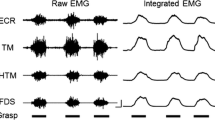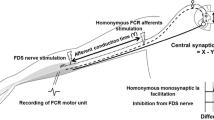Abstract
The H reflex obtained from the flexor carpi radialis muscle by median nerve stimulation is a well-known monosynaptic reflex. However, the origin of the late responses is still contentious. Radial nerve stimulation was performed through the spiral groove, and EMG recording was obtained from the flexor carpi radialis (FCR) and extensor carpi radialis (ECR) muscles. An M response followed by an F response was achieved from the ECR by radial nerve stimulation; the antagonistic FCR muscle elicited a late response. A total of 25 cases were included in this study. In 22 of these cases, a response with a latency of 40.97 ± 5.35 ms was obtained from the FCR by radial nerve stimulation. When extension of the hand was restricted, the response disappeared in five of nine cases. Application of cold markedly suppressed the response and prolonged the latency of the FCR medium-latency reflex response (FCR-MLR). Oral tizanidine considerably suppressed the FCR-MLR response. Two out of eight cases did not exhibit any response. No response could be recorded from a patient with complete amputation of the right hand. The FCR-MLR is the reflex caused by stretching of the FCR muscle from radial nerve stimulation, and it is greatly influenced by group II afferents.










Similar content being viewed by others
References
Bell RK, Lehmann JF (1987) Effect of cooling on H and T reflexes in normal subjects. Arch Phys Med Rehabil 68:490–493
Bras H, Jankowska E, Noga B, Skoog B (1990) Comparison of effects of various types of NA and 5-HT agonists on transmission from group II muscle afferents in the cat. Eur J Neurosci 2:1029–1039
Burke D, McKeon B, Skuse NF (1981) The irrelevance of fusimotor activity to the Achilles tendon jerk of relaxed humans. Ann Neurol 10:547–550
Burke D, Gandevia SC, McKeon B (1983) The afferent volleys responsible for spinal proprioceptive reflexes in man. J Physiol (Lond) 339:535–552
Burke D, Aniss AM, Gandevia SC (1987) In-parallel and in-series behavior of human muscle spindle endings. J Neurophysiol 58:417–426
Capaday C, Forget R, Fraser R, Lamarre Y (1991) Evidence for a contribution of the motor cortex to the long-latency stretch reflex of the human thumb. J Physiol 440:243–255
Corden DM, Lippold OCJ, Buchanan K, Norrington C (2000) Long-latency component of the stretch reflex in human muscle is not mediated by intramuscular stretch receptors. J Neurophysiol 84:184–188
Corna S, Grasso M, Nardone A, Schieppati M (1995) Selective depression of medium-latency leg and foot muscle responses to stretch by an a2-agonist in humans. J Physiol 484:803–809
Deuschl G, Schenck E, Lücking CH (1985) Long-latency responses in human thenar muscles mediated by fast conducting muscle and cutaneous afferents. Neurosci Lett 55:361–366
Deuschl G, Strahl K, Schenck E, Lucking C (1988) Diagnostic significance of long latency reflexes in multiple sclerosis. Electroencephalogr Clin Neurophysiol 70:56–61
Deuschl G, Ludolph A, Schenck E, Lücking CH (1989) The relations between long-latency reflexes in hand muscles, somatosensory evoked potentials and transcranial stimulation of motor tracts. Electroencephalogr Clin Neurophysiol 74:425–430
Ertekin C, Ertaş M, Efendi H, Larsson LE, Şirin H, Araç N, Toygar A, Demir Y (1995) A stable late soleus EMG response elicited by cortical stimulation during voluntary ankle dorsiflexion. Electroencephalogr Clin Neurophysiol 97:275–283
Ertekin C, Mungan B, Uludağ B (1996) Sacral conduction time of the soleus H reflex. J Clin Neurophysiol 13:77–83
Ghez C, Shioda Y (1978) Spinal mechanisms of the functional stretch reflex. Exp Brain Res 32:55–68
Grey MJ, Ladouceur M, Andersen JB, Nielsen JB, Sinkjær T (2001) Group II muscle afferents probably contribute to the medium latency soleus stretch reflex during walking in humans. J Physiol (Lond) 534:925–933
Hagbarth KE, Hagglund JV, Wallin EU, Young RR (1981) Grouped spindle and electromyographic responses to abrupt wrist extension movements in man. J Physiol 312:81–96
Hammond PH (1956) The influence of prior instruction to the subject on an apparently neuromuscular response. J Physiol (Lond) 132:17–18
Krogsgaard MR, Fischer-Rasmussen T, Dyhre-Poulsen P (2011) Absence of sensory function in the reconstructed anterior cruciate ligament. J Electromyogr Kinesiol 21(1):82–86
Kurusu K, Kitamura J (1999) Long latency reflexes in contracted hand and foot muscles and their relations to somatosensory evoked potentials and transcranial magnetic stimulation of the motor cortex. Clin Neurophysiol 110:2014–2019
Lee RG, Tatton WG (1982) Long latency reflexes to impose displacements of the human wrist: dependence on duration of movement. Exp Brain Res 45:207–216
Lourenço G, Iglesias C, Callavari P, Pierrot-Deseilligny E, Marcand-Pauvert V (2006) Mediation of late excitation from human hand muscles via parallel group II spinal and group I transcortical pathways. J Physiol 572(Pt2):267–284
Lourenço G, Iglesias C, Marchaud-Pauvert V (2007) Effects produced in human arm and forearm motoneurones after electrical stimulation of ulnar and median nerves at wrist level. Exp Brain Res 178(2):267–284
MacKinnon CD, Rothwell JC (2000) Time-varying changes in corticospinal excitability accompanying the triphasic EMG pattern in humans. J Physiol 528(Pt3):633–645
Malmgren K, Pierrot-Deseilligny E (1988) Evidence for non-monosynaptic Ia excitation of human wrist flexor motoneurones, possibly via propriospinal neurons. J Physiol 405:747–764
Marchand-Pauvert V, Nicolas G, Burke D, Pierrot-Deseilligny E (2002) Suppression of the H reflex by disynaptic autogenetic inhibitory pathways activated by the test volley in humans. J Physiol (Lond) 542:963–976
Marque P, Nicolas G, Simonetta-Moreau M, Pierrot-Deseilligny E, Marchand-Pauvert V (2005) Group II excitations from intrinsic foot muscles to human leg and thigh motoneurones. Exp Brain Res 161:486–501
Marque P, Pierrot-Deseilligny E, Simonetta-Moreau E (1996) Evidence for excitation of the human lower limb motoneurones by group II muscle afferents. Exp Brain Res 109:357–360
Matthews PB (1984) The contrasting stretch reflex responses of the long and short flexor muscles of the human thumb. J Physiol 348:545–558
Meskers CG, Schoutten AC, Rich MM, de Groot JH, Schuurmans J, Arendzen JH (2010) Tizanidine does not effect the linear relation of stretch duration to the long latency M2 response of m. flexor carpi radialis. Exp Brain Res 201(4):681–688
Nardone A, Schieppati M (1998) Medium-latency response to muscle stretch in human lower limb: estimation of conduction velocity of group II fibres and central delay. Neurosci Lett 249:29–32
Nardone A, Schieppati M (2004) Group II spindle fibres and afferent control of stance. Clues from diabetic neuropathy. Clin Neurophysiol 115:779–789
Nardone A, Giordano A, Corrà T, Schieppati M (1990) Responses of leg muscles in humans displaced while standing. Effects of types of perturbation and of postural set. Brain 113:65–84
Noth J, Podoll K, Friedemann H (1985) Long loop reflexes in small hand muscles in normal subjects and patients with Huntington’s disease. Brain 108:65–80
Pierrot-Deseilligny E, Burke D (2005) The circuitry of the human spinal cord. Its role in motor control and movement disorders. Cambridge University Press, Cambridge, p 642
Rack PMH, Ross HF, Thilmann AF (1984) The ankle stretch reflexes in normal and spastic subjects. Brain 107:637–654
Sammut R, Thickbroom GW, Wilson SA, Mastaglia FL (1995) The origin of the soleus late response evoked by magnetic stimulation of human motor cortex. Electroencephalogr Clin Neuropyhsiol 97:164–168
Schieppati M, Nardone A (1995) Time course of “set”-related changes in muscle response to stance perturbation in humans. J Physiol (Lond) 487:787–796
Schieppati M, Nardone A (1997) Medium-latency stretch reflexes of foot and leg muscles analysed by cooling the lower limb in standing humans. J Physiol (Lond) 503:691–698
Schimsheimer RJ, Ongerboer de Visser BW, Kemp B, Bour LJ (1987) The flexor carpi radialis H-reflex in polyneuropathy: relations to conduction velocities of the median nerve and the soleus H-reflex latency. J Neurol Neurosurg Psychiatry 50:447–452
Schuurmans J, de Vlugt E, Schoutten AC, Meskers CG, de Groot JH, van der Helm FC (2009) The monosynaptic Ia afferent pathway can largely explain the stretch duration effect of the long latency M2 response. Exp Brain Res 193(4):491–500
Simonetta-Moreau M, Marque P, Marchand-Pauvert V, Pierrot-Deseilligny E (1999) The pattern of excitation of human lower limb motoneurones by probable group II muscle afferents. J Physiol (Lond) 517:287–300
Sinkjær T, Andersen JB, Ladouceur M, Christensen LOD, Nielsen JB (2000) Major role for sensory feedback in soleus EMG activity in the stance phase of walking in man. J Physiol (Lond) 523:817–827
Suga R, Tobimatsu S, Taniwaki T, Kira J-I, Kato M (2001) The soleus late response elicited magnetic stimulation reflects agonist-antagonist postural adjustment in the lower limbs. Clin Neurophysiol 112:2300–2311
Tarkka IM, Larsen TA (1986) Short and long latency reflex responses elicited by electrical and mechanical stimulation in human hand muscle. Acta Physiol Scand 128:71–76
Uysal H, Larsson LE, Efendi H, Burke D, Ertekin C (2009) Medium-latency reflex response of soleus elicited by peroneal nerve stimulation. Exp Brain Res 193(2):275–286
Uysal H, Boyraz I, Yağcıoğlu S, Oktay F, Kafalı P, Tönük E (2011) Ankle clonus and its relationship with the medium-latency reflex response of the soleus by peroneal nerve stimulation. J Electromyogr Kinesiol 21:438–444
Acknowledgments
This study (2009.01.0103.013) was supported by Akdeniz University Scientific Research Grant. The authors would like to thank Mr. Fuat Akdenizli for his assistance with preparation of the medical illustrations.
Author information
Authors and Affiliations
Corresponding author
Rights and permissions
About this article
Cite this article
Uysal, H., Kızılay, F., İnel, Ş.E. et al. Medium-latency reflex response elicited from the flexor carpi radialis by radial nerve stimulation. Exp Brain Res 217, 223–235 (2012). https://doi.org/10.1007/s00221-011-2988-1
Received:
Accepted:
Published:
Issue Date:
DOI: https://doi.org/10.1007/s00221-011-2988-1




